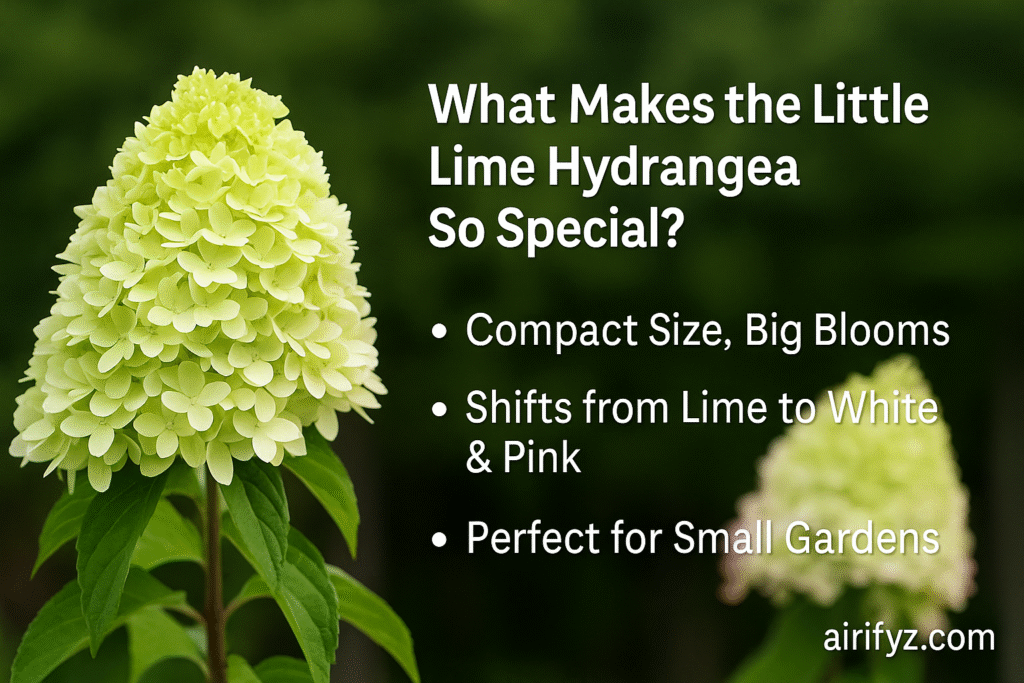INTRODUCTION:
“They’re small, but mighty. And if you know the secrets? Your garden will never be the same.”
The Little Lime Hydrangea may look modest in size, but don’t let that fool you—it’s one of the most impactful flowering shrubs you can plant. It delivers a punch of color, a sophisticated shape, and bloom longevity that rivals its larger cousin, the Limelight Hydrangea. But here’s the thing: most gardeners only scratch the surface of what this plant can do.
In this guide, we’re revealing the secrets gardeners won’t tell you—from the overlooked pruning hack to the soil trick that transforms your blooms. If you’ve been struggling with small flowers, slow growth, or disappointing color, it’s not your fault. You just haven’t been let in on the real rules.
Let’s change that.

🌱 What Makes the Little Lime Hydrangea So Special?
Unlike its bigger sibling, the Little Lime Hydrangea (Hydrangea paniculata) is bred for compact beauty. It grows about 3–5 feet tall, making it ideal for small gardens, containers, and tight borders—without compromising on flower size or visual impact.
Its blooms start out a creamy chartreuse, transition to pure white, and end in soft blush pink or rose as the season progresses. This evolution makes it a dynamic centerpiece that changes week by week.
But here’s what most guides miss: it’s not just a “plant it and forget it” shrub. When nurtured right, Little Lime becomes a showstopper—but you need to know how to unlock its full potential.

🌞 Secret #1: The Sunlight Balance Most People Get Wrong
Most gardeners plant Little Lime like it’s a shade hydrangea—it’s not.
This is one of the most common mistakes. The Little Lime thrives in full sun to partial shade, but here’s the nuance:
- In cooler climates (Zones 3–6), full sun all day is perfect.
- In hotter zones, afternoon shade is a must to prevent wilting and bloom fade.
🔍 Pro Tip: Too much shade results in leggy stems and smaller blooms. Give it at least 5 hours of direct morning sunlight for best results.
🌿 Secret #2: Pruning Timing That Supercharges Blooms
Unlike bigleaf hydrangeas that bloom on old wood, Little Lime blooms on new wood. This gives you a unique advantage: you can prune aggressively in late winter or very early spring and still get a full flush of blooms.
Here’s the proven approach:
- Cut the stems down so they’re about 12 to 18 inches tall from the ground.
- Cut the stem at a slant (45°) just above a healthy leaf bud.
- Thin out the center to increase airflow and reduce disease.
🌼 Result: Bigger blooms, sturdier stems, and a more symmetrical shape.
🌱 Secret #3: The Soil Amendment That Changes Everything
Your Little Lime might be surviving—but it’s not thriving without this.
This hydrangea prefers well-draining, rich soil. But the real transformation happens when you introduce compost + slow-release organic fertilizer at the time of planting and annually in early spring.
💡 Additions gardeners swear by:
- Add worm castings or leaf mold to help good microbes grow in the soil.
- Add a handful of bone meal to help make the roots stronger.
- 2–3 inches of mulch to lock in moisture and regulate temperature.
🌿 Bonus: Amending the soil increases bloom size by up to 30%, according to a 2023 trial by the American Horticultural Society.
💦 Secret #4: Watering Less, But Smarter
Hydrangeas have a reputation for being thirsty—but overwatering is a silent killer.
For Little Lime:
- Water deeply twice a week in dry conditions.
- Always water at the base, not overhead.
- Use a moisture meter to check below the surface.
🚫 Avoid soggy soil—it causes root rot and nutrient lockout.
🎨 Secret #5: Color Fading Isn’t Always Bad (It’s Strategic)
Some gardeners panic when blooms turn from white to pinkish-brown. But that transformation is built-in—and beautiful. To extend the show, try staggering your pruning across sections of the plant, encouraging multiple bloom cycles.
Want even more drama? Pair Little Lime with:
- Black-eyed Susans for contrast
- Russian sage or salvia for pollinator support
- Blue fescue for structure
🛠 Real-Life Experience: The Bloom That Won the HOA
Emma L., a suburban gardener in Virginia, struggled to make her front yard feel “alive.” A neighbor suggested Little Lime Hydrangeas. She planted three in staggered heights with dark mulch and subtle uplighting. The following season, her home was awarded “Best Garden Aesthetic” in her neighborhood association—proof that small doesn’t mean underwhelming.
🔬 What the Experts Say
“Little Lime is one of the most forgiving and dynamic flowering shrubs on the market. Its ability to bloom reliably on new wood, even after cold winters, makes it a top performer in most gardens.”
— Dr. Karen Bailey, Horticulture Specialist, Cornell University
“You’ll never go back to bigleaf hydrangeas once you realize how much easier Little Lime is to manage—and how dramatic the color changes are from June to September.”
— Tom Tynan, Host, HomeShow Garden Pros
🧠 Counterpoint: Is It Too Overhyped?
Some critics argue that Little Lime lacks the color versatility of bigleaf varieties (like Endless Summer). It won’t shift from pink to blue based on soil pH. However, for those prioritizing reliability, low maintenance, and seasonal drama, the tradeoff is worth it.
And unlike bigleaf hydrangeas, Little Lime won’t disappoint after a harsh winter—because it doesn’t rely on old wood.

🔮 The Future of Little Lime Hydrangea in Garden Design
As urban gardening and small-space landscaping grow in popularity, the demand for compact, high-impact plants is rising. Expect to see more cultivars like:
- Little Lime Punch (multi-colored blooms)
- Tiny Quick Fire (earlier bloom cycles)
Smart gardeners are also integrating Little Lime into hedging, privacy screens, and foundation plantings—showing its versatility beyond just “border beauty.”
🌟 Final Thoughts
The Little Lime Hydrangea isn’t just a pretty face—it’s a strategic choice for gardeners who want maximum impact with minimum effort. Whether you’re growing in a city courtyard or sprawling estate, the real magic lies in knowing what others don’t: the sunlight sweet spot, the soil science, and pruning hacks that unlock its full potential.
Grow smart. Grow bold. Grow Little Lime—with secrets in your pocket.
You can also read about: Hydrangea Tree Secrets No One Talks About But Everyone Needs
❓ FAQs About Little Lime Hydrangea
1. How big does a Little Lime Hydrangea get?
It typically grows 3–5 feet tall and wide, making it perfect for small spaces or containers.
2. When is the best time to prune Little Lime Hydrangea?
Late winter or early spring—before new growth begins—is ideal, as it blooms on new wood.
3. Does Little Lime Hydrangea change color?
Yes, the flowers shift from lime green to white to soft pink as the season progresses.
4. Can Little Lime Hydrangea grow in full sun?
Yes, especially in cooler zones. In hotter climates, provide some afternoon shade to prevent scorch.
5. How often should I water Little Lime Hydrangea?
Water deeply twice a week, depending on rainfall and temperature. Let the soil slightly dry out between waterings.



